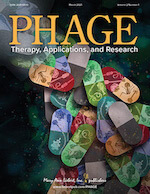This week I wanted to try something new. A Q&A from the phage community! Sometimes we get questions from labs, researchers, companies, about our thoughts or advice on a particular area of phage work.
Here’s a question I got from a researcher setting up a phage therapy center in their lab, and my (real, lightly edited for clarity) reply that I sent to her.
I thought I’d also share it here so all can benefit!
Question:
As you know, we are currently setting up a small-scale lab for personalized phage therapy production. I would be very grateful if you could share the specifications or recommendations for the equipment you used [during your time at Phage Australia], particularly the ultrafiltration (UF) system.
My answer:
Hi, thanks for asking! I love this question! The equipment I really like for phage production and quality control is:
For tangential flow filtration (TFF)
For column chromatography
- AKTA Pure 25 (FPLC system; same as many use for protein purification - basically the base model is all you need, but there are various components you can choose between depending on how flexible you want to be)
- Consumables:
For verifying endotoxin levels at the end
- Nexgen endotoxin reader from Charles River - this is the best! And can buy FDA-approved cartridges. We just got one. (Regular price ~10k, we got a hefty discount, so I leapt at the chance; have to buy cartridges so each sample will cost around 40$ to test; therefore this reader is ideal for final product testing but not if you’re doing lots of samples as part of R&D)
If you have limited budget:
- Instead of AKTA flux S, you can get a Sartorius Vivaflow (and secondhand or new peristaltic pump) (see Tiffany Luong’s awesome paper on this)
- Instead of AKTA pure, you can use octanol (see Phage on Tap paper) to remove endotoxin — we did this for some of our patient preps in Australia, worked well; just use dialysis to remove octanol after)
- Instead of Endotrap columns for AKTA pure, you can buy the gravity columns and not need the AKTA pure at all - this works well, just needs more time
- Instead of Nexgen endotoxin reader, can use Biomerieux Endozyme II kit or similar - more laborious than Nexgen and not FDA approved, need to validate yourself / can be annoying to set up, but doable
- Instead of TFF you can use Amicon spin columns (see Phage on Tap paper) and dialysis after you’ve got a purified prep
We are going through process of trying to get funding for these here at Stanford. That said, we are likely going to get Vivaflow cartridges and a peristaltic pump (1-3k online) instead of AKTA flux for now. And we already have an old AKTA Purifier (old model of the AKTA Pure) so we are using that for now - works great, just it may die and when it does, we will have no manufacturer support. We have the Nexgen reader now but also have the Endozyme II kit for when we have a lot of samples.
Hope this helps, happy to help if any of this is confusing! If you tell me your approximate budget I can suggest what you should choose among all those things.
Jessica
P.S. For those who want to dive deeper, here are the slides from a talk I gave on using TFF for phage purification at Evergreen 2025 (which just happened!) for the Phages for Global Health Phage Purification Workshop!
Send us your questions!
There you have it — our first Phage Community Q&A post. Let us know how you like this format so far!
And if you have your own question, or something you want advice on in the phage lab (or computational space), or a piece of equipment you want advice on before you buy, email us at [email protected]! We might not know, but we’ll see if we can get your question answered by someone in the phage field!







